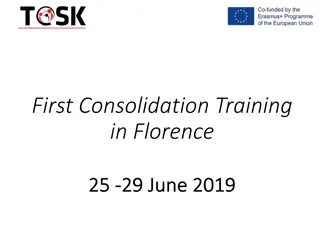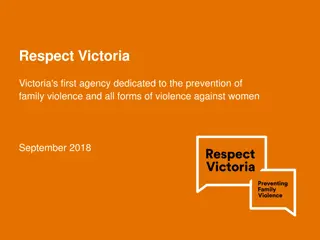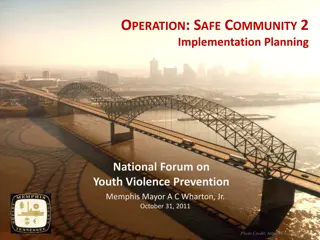Community-Based Anti-Violence Strategies and Models: Insights and Challenges
Strategies and models for addressing community-based violence involve integration of key groups, including religious organizations, outreach workers, and historical considerations. US models like OJJDP, LA GRYD, Boston Ceasefire, and Chicago Cure Violence offer comprehensive approaches. The Response Pyramid outlines offender involvement levels. Challenges include cultural variations in risk factors, economic barriers to engagement, dearth of data, and weak social institutions. Advantages lie in reduced treatment interference, strong social structures, economic growth, and regional stability through Latin America and the Caribbean.
Uploaded on Dec 14, 2024 | 0 Views
Download Presentation

Please find below an Image/Link to download the presentation.
The content on the website is provided AS IS for your information and personal use only. It may not be sold, licensed, or shared on other websites without obtaining consent from the author. Download presentation by click this link. If you encounter any issues during the download, it is possible that the publisher has removed the file from their server.
E N D
Presentation Transcript
Community Based Anti-Violence Strategies April 11-12, 2018 Scott H. Decker
Community Based Anti-Violence Strategies Build on growing body of evidence regarding violence Much of it ethnographic, heavy European involvement (Rodgers, French teams, British) More local research than initially thought Gangs are not the entire issue Guns, political conflicts, extreme poverty
Community Strategies 1.Integrate key community groups and agencies 2.Role of religion and religiosity 3.Outreach workers 4.Best source of leadership? 5. Recognize historical disputes and alliances
US Models Comprehensive Strategy (OJJDP) LA GRYD (Risk factor-based) Boston Ceasefire (accountability) Chicago Cure Violence (PH emphasis) SUPPRESSION only (training, Task Forces) First four balance suppression with interventions First four include strong community component
The Response Pyramid Serious & Chronic Offenders Share of Illegal Activity Active Offenders High Risk for Involvement in Violence Children and Adolescents at General Population of Youth and Families Living in High Risk Areas Relative Share of Population
A MODEL OF Criminal Involvement (Violence involves older groups) 1 0.9 0.8 Criminal Involvement 0.7 0.6 Onset Termination 0.5 0.4 0.3 0.2 0.1 0 10 11 12 13 14 15 16 17 18 19 20 Age in Years
Challenges 1. Are risk factors constant across cultures and countries? 2. Does extreme poverty and lack of economic development hinder community engagement? 3. Lack of databases on many risk factors and outcome measures may hinder model development 4. Role of economic crime in family support 5. Weakness of social institutions
Advantages 1. Multiple treatment interference less of a problem 2. Strength of many social institutions (family, church) 3. General improvement in economies 4. Critical role for Latin American and the Caribbean in regional stability.
Big Questions 1. Will American models work? 2. How to make interventions local ? (Community) 3. Can funding be found and sustained? 4. Will European support be forthcoming? 5. Will community residents participate at sufficient levels to produce change?


![READ [PDF] Sliding into Home (The Decker Connection)](/thumb/42245/read-pdf-sliding-into-home-the-decker-connection.jpg)




















